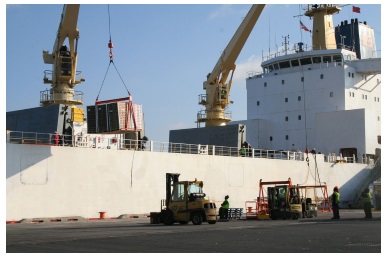Reefer Trade: Wilmington (DE); Wilmington (NC)
![]() Print this Article | Send to Colleague
Print this Article | Send to Colleague
The first breakbulk shipment of Chilean winter fruit of the 2016-17 season to reach the United States arrived December 14 at the Port of Wilmington (DE).
The cargo delivered that morning by M/V Hellas Reefer consisted of some 992,100 boxes of fresh cherries, blueberries, apricots, peaches, nectarines, and table grapes. Wilmington is a major port of entry and distribution center for the seasonal importation of fresh Chilean winter fruit. During this season, the port is expecting at least 25 shiploads of fruit from the Chilean ports of Valparaiso, Coquimbo, and Caldera.
Fruit cargo is stored in the port’s 800,000 square-foot on-dock refrigerated warehouse complex pending distribution throughout Canada and the eastern United States. During the 2015-16 season, the port received more than 15.4 million boxes of Chilean fruit. That trade is of great economic importance to Delaware and the region, supporting more than 851 family sustaining jobs and annually generating $48 million in personal income, $51 million in business revenue and $5 million in tax revenue.
"The arrival of the Hellas Reefer marks the seventh year in a row that the First State has had the opportunity to receive the season opening breakbulk shipment of Chilean winter fruit, not only on the Delaware River but in the entire United States," said Port Executive Director Gene Bailey. "It is our pleasure to once again directly support the trade interests of our partners and customers in providing U.S. and Canadian consumers with the freshest possible fruit for the holidays."

Hellas Reefer discharging fruit at the Port of Wilmington
Photo/Port of Wilmington
Wilmington Cold Storage Offers First In-Port Cold Storage Facility in North Carolina
Port of Wilmington Cold Storage (PWCS) recently opened a 101,000 square foot refrigerated warehouse within the gates of the Port of Wilmington. Designed for the storage of fruits, vegetables and proteins, it is the first in-port cold storage facility in North Carolina.
PWCS is a joint venture of the North Carolina State Ports Authority (NCSPA) and USA InvestCo, a Wilmington-based real estate development and investment firm. The warehouse is wholly owned by USA InvestCo. It is located on property owned by the ports authority and leased to USA InvestCo. Total cost for the project was $17.5 million, which includes pre-development, construction and opening operating expenses.
"Agriculture is an $84 billion industry for North Carolina and the #1 industry in the state," said Chuck McCarthy, the company’s president and CEO. "And the demand for U.S. meats and vegetables abroad is very high, particularly in Asia. We anticipate that PWCS is going to allow NC producers and processors to significantly grow their export business by providing them with a more cost-effective alternative to trucking their products to out-of-state ports. And we also hope that local growers who may have thought export was out of their reach will consider working with us to help them grow their market overseas."
PWCS offers nearly 3.0 million cubic feet of freezer and cooler space and 10,600 pallet positions. The warehouse’s primary include a convertible room that can be used for refrigerated or frozen products; a freezer room where temperatures are maintained below zero degrees, and a blast freezing room where products like chicken and pork can be frozen to zero degrees within 24 hours. USDA inspection is provided on-site.
PWCS has a loading dock with 11 truck bays to allow for quick transfer of product into and out of the warehouse. Ceiling heights range from 35 to 40 feet high.
PWCS offers both cooling and freezing services, with temperatures ranging from -10 to 40 degrees Fahrenheit. On-site blast freezing is available for up to 200 pallets per day.
"The #1 advantage of being located within the port is that we are able to pack containers with more product at less cost," said Mr. McCarthy. "A shipping container loaded at the port can hold 60,000+ pounds of product, versus a container loaded inland, which can only hold a maximum weight of about 57,000 pounds. Trucks are regulated on the weight they can carry over roadways, but our shipping containers never leave the port, so they can carry a heavier load. We can pack 5 percent or more product in a shipping container, which translates into considerable savings for our customers."
"Customers and carriers seeking cost-effective and efficient solutions continue to find even greater resources available at North Carolina Ports," said Ports Authority Executive Director Paul J. Cozza. "The Port of Wilmington Cold Storage facility is a major part of our modernization plan, offering convenience, logistical support, expedited delivery times, and substantial savings for protein providers on transportation costs."

